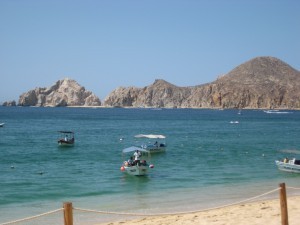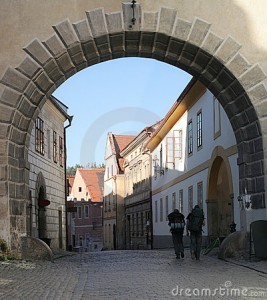Rolf Potts's Blog, page 86
July 21, 2012
Sun and Sand in Cabo San Lucas
Vagablogging :: Rolf Potts Vagabonding Blog
Cost/day: $60
I thought the ingredients for a great time at the beach were sun, sand, water and maybe a little mariachi music. That was before I saw the pirate ship in all its glory. It was full-size, fully beached, and had a water slide running through the middle of it.
The pirate ship slide is fairly emblematic of my entire stay in Cabo, not really authentically Mexican, but so fun I didn’t care.
A typical day starts around 8, when the heat of the Baja sun wakes you up and requires an immediate plunge in the ocean. The water down here is warmer than most swimming pools, and because it’s on the Sea of Cortez, it gently laps against the endless stretch of sand. Lay down on the beach and let the sun dry you off, maybe flex some of your Spanish muscle and chat up a beach vendor. Hopefully your Spanish is better than mine, or you could end up with a dozen ponchos and an offer to bring back more the next day.
Then head back to the hotel for some huevos rancheros. Stellar deals abound on last second deals for condos in the summer, almost all of them are independently owned and listed on VRBO and Airbnb. With summer being the low season in Cabo, owners are eager to cover costs and rent out the condos at rock-bottom prices if you’re comfortable booking at the last minute (if you’re reading this blog, then I’m guessing this is right up your alley).
For breakfast and lunch, most condos have a kitchen and there is an enormous Costco and Walmart. Load up on food here and you’ll save quite a bit, as many restaurants in Cabo charge American prices due to the high number of tourists. If you surf and are going to be in town for more than a few days it’s a good idea to buy a board at Costco for $99. It sounds like a lot of money, but rentals are about $20/day, so it’s actually cheaper and you can probably sell it to someone doing the same thing as you and recoup about half your investment.
The afternoon is national siesta time, and I always recommend doing as the locals do. The siesta is as much a retreat from the beating heat of the afternoon as it is a recovery from the late nights of Cabo.
When the evening rolls around, the four or five blocks that make up downtown Cabo come alive. The restaurants can be pricier than expected, but I highly recommend a diamond in the rough called “Tacos Fiesta”. It’s not for the meek, but if you want phenomenal Mexican seafood and don’t mind no frills dining this is the place for you. Dinner for two, plus as many drinks as you can handle for about $20.
At night, if walks on the beach aren’t your thing, Cabo has no shortage of activities. Avoid Cabo Wabo (owned by Sammy Haggar), Senor Frogs, the Giggling Marlin, etc. and aim for something more local. Just head into whatever smallish bar looks to be crowded and you’ll be making friends with longtime expats and locals in no time. There are literally a dozen options to choose from in a two block radius.
 About 70% of the population of the Cabo area is expats. Not surprising considering Cabo started as a speck of a fishing village and growth was entirely fueled by international tourism. There’s an endless source of great stories and life manifestos to hear surrounding why and how many of these expats changed their latitudes and headed for Baja. If you have thirty minutes and want some inspiration to quit your job, buy a bucket of cervezas and hop on the barstool next to anyone looking particularly tan and relaxed.
About 70% of the population of the Cabo area is expats. Not surprising considering Cabo started as a speck of a fishing village and growth was entirely fueled by international tourism. There’s an endless source of great stories and life manifestos to hear surrounding why and how many of these expats changed their latitudes and headed for Baja. If you have thirty minutes and want some inspiration to quit your job, buy a bucket of cervezas and hop on the barstool next to anyone looking particularly tan and relaxed.
I personally love the excitement and attitude of Cabo. Everyone is here to have a great time and between the weather and the siestas it’s impossible not to enjoy yourself. However, Cabo is definitely not authentically Mexican and this irks some. A nice remedy to this is to drive an hour north up the coast to Todos Santos, a bohemian Mexican hamlet full of surfers and painters. It’s similar to what Cabo was two decades ago and allows travelers to get a taste of both sides of Baja.
A particular challenge I faced was trying to find a rented shack on the beach in Todos Santos after dark. There are absolutely no street lights and no one walking around this sleepy little town at ten p.m. My directions were not the best I’ve ever worked with and frustration was mounting. By 11 p.m. I was ready to give up, then my girlfriend pointed to the right and said, “There it is!” And so there it was, a little shack on the beach, all by itself. I gleefully swung the wheel and drove our tiny rental car towards our destination…and straight into a sand dune.
Believe it or not, the Toyota Camry doesn’t have four-wheel drive (crazy, right?) and we were officially stuck in the dark in the middle of nowhere, and I can only assume being closed in on by the local vicious Mexican sea turtles. Once I established the sea turtles were not an immediate threat we started considering our options, there seemed to be none. So I did the only rational thing I could think of, I turned on the car alarm and waited for a sleeping local to get tired of the noise and come find us.
Ten minutes later, the Mexican police showed up and the standard bribe of $20 had us towed out and on our way. They even saluted us as we waved and drove away because they had only requested $15.
That was probably the biggest lesson I learned. Don’t drive off into the dark with bad directions and only twenty dollars. If those gracious federales had wanted $25, we would still be stuck in a sand dune.
Up next…Epernay, the heart of the champagne region in France!
Original article can be found here: Sun and Sand in Cabo San Lucas
Vagabonding Field Report: Over-landing Southern and Eastern Africa
Vagablogging :: Rolf Potts Vagabonding Blog
Cost/day: $50-75
What’s the strangest thing you’ve seen lately?
In Malawi I was introduced to the water spirit Tokoloshe. It resembles a human figure – two hands and two feet – but with extremely exaggerated features like the massive belly and enormous mouth and tongue. I have never seen anything quite like it and decided I had a buy one. Luckily, there’s a million craft stalls in Africa and Malawi is no different. I bought mine from a fellow that called himself “Cheap As Chips”.
Describe a typical day:
Over-landing in Africa is a game of endurance. The roads are long and generally not in good conditions. For that reason, I often get an early start – usually around 5am and on the road at 6am with a lunch stop along the side of the road before camping in the early afternoon. Sometimes I’ll have an afternoon hike before pitching tents and making dinner. The evenings are usually short but almost always amazing due to the incredible clarity of the African night skies. Africa is really blessed to be almost completely devoid of light pollution is vast regions of the continent. This makes for some of the best star gazing I have ever had.
On days where I stay put in one location for a while, the day’s activities can be anything from swimming in Lake Malawi or lounging on the beaches of Zanzibar or climbing the 16km road up to the top of a mountain to visit the Livingstonia mission.
The only other constant is the presence of street vendors looking to sell or trade their crafts. All across Africa you’ll find artists making masks, wooden picture frames, bracelets from copper wire or just plain images of the Big 5.
Describe an interesting conversation you had with a local:
I helped a woman in Livingstonia retrieve a tree branch which had become lodged in a second tree. Over the course of 25 minutes, we had something close to a “conversation” although since we didn’t speak a common language, it mostly amounted to a series of hand gestures, pointing and smiles. I was ultimately able to knock the branch out of the tree and judging by her relatively small firewood bundle, the branch was the daily prize and she genuinely seemed quite happy as she thanked me. Sometimes language isn’t required to have a simple and rewarding exchange.
What do you like about where you are? Dislike?
Africa has some incredible and varied landscapes with equally stunning wildlife that you simply can’t see anywhere else in the world. Every day brings images of life in Africa that I never seem to tire of. From the deserts and to the Okavango Delta in Botswana, Africa has some incredible sights that simply blow your mind.
At the same time, Africa clearly has enormous obstacles to overcome with arguably the single greatest obstacle being the challenge of containing the spread of HIV. The virus takes a difficult economic situation and makes it devastating. The resulting poverty – unfortunately compounded by corruption – is heart wrenching and forces you to be very mindful of your self and possessions at all time. While I’ve always been alert to my surroundings while traveling, on a number of occasions I’ve had to be particularly careful while in Africa. This is exhausting and emotionally challenging.
Describe a challenge you faced:
Although not a challenge exactly, I did try my hand at poling a Mokoro in the Okavango delta. A mokoro is a dug out shallow canoe which is propelled by a poler who stands at the back of the boat using a very large pole (hence the poling title). I spent an hour humbly trying to move the boat in a straight line before retreating in relative defeat.
What new lesson did you learn?
Poling is incredibly difficult! The guides in the Okavango delta are incredibly skilled at it and I was amazed to find out how difficult it is to do. Imagine standing on a balancing ball and then juggling at the same time and you get a sense of just how difficult it is. My hat goes off to the guides for their incredible skill.
Where next?
Heading back home to Toronto for a few weeks to recharge before moving on to South America.
Original article can be found here: Vagabonding Field Report: Over-landing Southern and Eastern Africa
July 20, 2012
Interested in Round the World Travel?
Vagablogging :: Rolf Potts Vagabonding Blog
Extended, round the world travel has been gaining plenty of steam over the last decade here in the United States. And while it isn’t an accepted, mainstream way of traveling quite yet, I do feel like it’s at least on the way.
It’s difficult to undo generations of teaching and upbringing, which is why there’s still a whole lot of people out there who love to travel, have possibly thought of taking extended time off to travel, but then quickly wrote it off as being not possible simply because that’s not what we’re supposed to do.
What we’re supposed to do is go to college, get a job, get married, buy a house, have 2.3 kids, cars, televisions, gaming systems, and a plethora of what some would call crap to fill those big houses. When you’ve grown up hearing and living this type of life, it’s difficult to just throw caution to the wind and say “Screw it! I’m not doing it that way!”
But that’s what we’re all about over at BootsnAll. We hope to encourage more people to realize their dreams and say, “Screw it! I’m not doing it that way!” We urge travel lovers to take that leap of faith. To ignore all those round the world travel myths and get out there and see the world – for more than one week at a time.
In addition to all the content we have on our site aimed to help people travel around the world, we have a few new resources meant to connect you with others and realize just how many people are out there right now doing this sort of thing.
This past Wednesday marked the inaugural BootsnAll Round the World Twitter Chat (#rtwchat). Every Wednesday starting at 3:30 EST we are hosting a chat on twitter that is solely based on RTW travel. It’s a great way to share ideas, resources, and just chat with lots of other like-minded people who are interested in, actively planning, on, or veterans of extended travel. We’d love for you to join our new community and take part in the fun!
So be sure to join us next Wednesday when the topic will be Planning your RTW Route.
Original article can be found here: Interested in Round the World Travel?
July 19, 2012
Comments and conversations
Vagablogging :: Rolf Potts Vagabonding Blog
There were a lot of comments on my last blog entry for this site, relative to the normal amount these posts receive. (“The What-ness, part 2: Choose what to lose”, can be read at http://www.vagablogging.net/the-what-ness-part-2-choose-what-to-lose.html). The post was about avoiding easy clichés and sterile recounting in your travel writing, and putting in the effort to drill down into the core experience and character of the place.
The comments were very thoughtful and generally reiterated the importance of trying to avoid, in one commenter’s words, “play by play A-B accounts of been there, did this and ate that.” He continued, “What I really want when I pick up a travelogue is to know about the people of a place that make the place special but instead.”
Yes!
Another commented, “I like to focus on the senses and relationship. While I often include part of what you’re talking about as a framework, I’ll fill in around it with what I see, taste, smell, touch, and hear and how it relates to my emotions, past experience, and present experience.”
That’s exactly right, and it’s the conversation I meant to inspire. It’s also indicative of the fact that many people find travelogues to be dry, adjective-based accounts of “I did this and went here, and it was (hot/cold/rainy/lame/expensive)”.
When recounting the day’s events in your journal or penning an article for readers eager to be transported by your words, search for insights and rich sensory data that give flesh to the bones of description.
The planet and its inhabitants are marvelously diverse. Our little blue marble is teeming with stories waiting to be told. Those stories deserve your best. Ditch the adjectives and dig deep.
Original article can be found here: Comments and conversations
Can development ruin our experience of a place?
Vagablogging :: Rolf Potts Vagabonding Blog
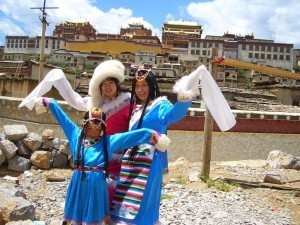
I lived in China as a foreign expert teacher in 2007/2008: back then, things were definitely starting to look like the country would have immensely changed. Grey skeletons of new mass construction works were scarring the land all over, so much that, month by month, the only similar thing on a city bus route was its number. Everything was changing, puffing in smoke and construction fumes. Beijing, as it was preparing for the crucially important 2008 Olympic Games, looked like a lady under heavy testosterone reconstruction. China smelt like burnt plastic, containers and rotting nylon clothing. But there were of course some really fantastic places hidden in the countryside, and a few, such as the province of Yunnan in China’s extreme southwest, emanated real travel bliss.
Well, I have been In China several other times since then, and I am writing this piece from China itself. The country has changed, including my loved Yunnan province. The smallish, relaxing municipalities morphed into old towns attached to hyper-technologic concrete slabs of buildings that honestly look all the same. The renewed Chinese wealth has transformed what was a characteristic of development, excitement and difference before, into another pre-packaged bunch of skyscrapers and block of flats. Where I am now, in Zhongdian, the first Tibetan settlement of Yunnanese Kham, the Old City – which was THE CITY back then – has become a tourist ghetto where prices are higher and tour buses vomit hordes of local and international tourists looking for a pre-packaged Tibetan experience made of hot pots, car rides along the grasslands and infernal shopping.
Is development making me upset? Well, a tiny bit. It is of course great to see how people who were living in ramshackle barracks can now afford the comforts of a shiny new block of flats. But… my memories are suffering a castration, and scream like a mad eunuch at the court of Kublai Khan.
I still try to be positive and take a walk around this city that has now become a sprawling concrete slab polluting the idyllic, rugged mountain plateau at the background. I cannot see it anymore, unless I climb on the new, freshly constructed Tibetan gompas where you pay 5$ to enter and can have the most real of the fake Tibetan experiences. Everyone local in town seems busy trying to rent out his car services, or pushing you into one of the many souvenir and outdoor gear shops. Of course, nothing wrong in making a profit and turning the town into a tourist hotspot, that hopefully may benefit the local economy. The surrounding countryside is still beautiful and worth to be seen, but again, my eunuch is screaming. Screaming at how now I have to take a bus to get across that lovely patch of land grazed by yaks. Or that I have to pay an extortionate amount for what was almost free and infinitely more authentic just 4 years ago.
I do not know. I will suck it up, ok. But do not tell me that development and memories have decided to go to the prom together this year. Maybe it would be best if I avoided returning to some of the places I loved most… what do you think?
Marco Ferrarese has been living la vagabonding vida loca in Asia since 2007 and has extensively traveled in about 50 countries and 4 continents. When he is not on the road he lives in Penang, Malaysia, where he plays punk rock guitar, writes and studies extreme rock music in Southeast Asia for Monash University. Follow him at www.monkeyrockworld.com
Original article can be found here: Can development ruin our experience of a place?
July 18, 2012
The world happiness party
Vagablogging :: Rolf Potts Vagabonding Blog
It’s not every day you see a 1985 camper painted like a giraffe.
I’d spotted this distinctive vehicle a few times over the past week and a half. But as luck would have it its driver, Steve pulled in behind me at the post office parking lot. Across both sides in large white letters reads, “The World Happiness Party.com”
I could have jotted down the web address or taken a photo with my smart phone. Rather than create a digital distance, I walked up to the cab of his camper and waved.
He began rolling down his window before I’d gotten close enough to exchange conversation…
“So I’ve got to ask, “, I said, “What is the world happiness party?”
“It’s a rigorous branch of psychology which studies how people can learn to be happier.”
I simply nodded, hoping he’d continue to explain; which he did in many of the same words written on the above mentioned website along with a few added twists.
In the first paragraph, it states, “The science of happiness is a rigorous branch of psychology which studies how people thrive and enjoy fulfilling lives.” A little farther down it offers:
“7 WAYS TO INCREASE HAPPINESS”
1) Strengthen friendships & family ties.
2) Get proper exercise.
3) Smile & laugh more. Savor life’s joys.
4) Cultivate optimism.
5) Practice generosity & philanthropy.
6) Develop a purpose in life.
7) Manage stress.
Had I not gotten into a face-to-face conversation with Steve I’d probably had less patience to scroll down the stark-white single home page of seemingly endless text. But some 3,500 odd words later it did end; repeating his mobile number several times and listing 24 pan-human character strengths:
“Strengths of wisdom and knowledge”
Creativity: thinking of new, sometimes artistic ways to do things
Curiosity: finding all topics fascinating; exploring and discovering
Love of learning: mastering new skills and knowledge
Open-mindedness: openness to alternative ways of thinking
Perspective: being able to offer wide counsel to others
“Strengths of courage”
Authenticity: speaking the truth in a genuine way; taking responsibility
Bravery: not shrinking from challenges; doing what’s right regardless
Persistence: finishing what one starts despite obstacles
Zest: living life with excitement and energy
“Strengths of humanity”
Kindness: caring, helping and doing good deeds for others
Love: valuing close relations with others
Social intelligence: being aware of the motives and feelings of others
“Strengths of justice”
Fairness: treating all people fairly, justly and without bias
Leadership: offering encouragement and direction to groups
Teamwork: working well as a member of a group or team
“Strengths of temperance”
Forgiveness/Mercy: forgiving others; not being vengeful
Modesty/Humility: not thinking oneself more special than one really is
Prudence: being careful about one’s choices; not taking undue risks
Self-regulation: being disciplined; controlling one’s appetites and emotions
“Strengths of transcendence”
Appreciation of beauty & excellence: … in nature, art and science
Gratitude: being aware of and giving thanks for good fortune
Hope: believing that a good future can be brought about
Humor: liking to laugh, play and smile
Religiousness/Spirituality: belief in higher purposes
The “7 ways to increase happiness” jogged my memory about a book I read on my first long journey entitled, “Eight Mindful Steps to Happiness: Walking the Buddha’s Path” The Noble Eightfold Path goes as follows:
1) Right view
2) Right intentions
3) Right speech
4) Right action
5) Right livelihood
6) Right effort
7) Right mindfulness
8 Right concentration
Both ultimately strive for the same purpose in slightly different words. Musing on this I tried to look up the dictionary definition of the word eupsychia (from theworldhappinessparty website)—to no avail.
A few pages into the introduction of “Vagabonding”, Rolf Potts says he’s never found the word [vagabonding] in any dictionary, along with noting, “It made me realize that, whatever name you give it, the act of vagabonding is not an isolated trend so much as it is (to crib a Greil Marcus phrase) a ‘spectral connection between people long separated by place and time, but somehow speaking the same language.’”
So, crack open his book to the contents page and just focus on the bold lettering of each chapter:
1) Declare Your Independence
2) Earn Your Freedom
3) Keep it Simple
4) Learn, and Keep Learning
5) Don’t Set Limits
6) Meet Your Neighbors
7) Get into Adventures
8 Keep It Real
9) Be Creative
10) Let Your Spirit Grow
11) Live the Story
So is the science of happiness, the noble eightfold path and vagabonding at essence the same?
In conclusion I “met my neighbor” who’d converted, as he said, “The world’s ugliest vehicle.” into something better camouflage for the African savannah. This bold camper transports Steve on 6 month rotations between one city to another, and everywhere in-between. Much of the time he lives under the giraffe cloak parking at places like Wal*mart (which allows free camping) for the night. During our brief conversation we talked about the crumbling structure of rural communities– within America and around the world—and how travel shapes us.
“My home is a 43 foot horse trailer.” I said, “and I’ve camped at Wal*marts across the US and Canada. I also write weekly for an independent travel blog.”
“I’ve actually studied the psychology of travel more than happiness.” Steve replied.
He wrote down his mobile number and email address on the back of a blue slip of paper and handed it to me out his window.
The front reads: “FREE TICKET to EU-PSYCHO-TOPIA!”
Original article can be found here: The world happiness party
July 16, 2012
Do more dreams die because of lack of money or because of the fear of the unknown?
Vagablogging :: Rolf Potts Vagabonding Blog
Most dreams die because the dreamers can’t take the requisite and always terrifying step into the unknown. The best laid plans and sincerest intentions are no protection against the stomach-lurching sensation when you let go of the lifeline.
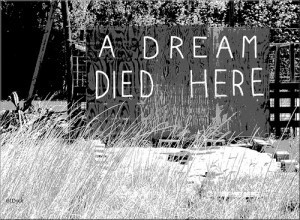 Cila Warnke is currently writing a book – THE BOOK, as she refers to it. Here’s her description: The Book tells the stories of people who refuse to go gently into the fiction of “normal” life. They have confronted all the usual excuses for saying “no” (children, illness, age, lack of opportunity) and with cheerful, bloody-minded determination said “yes” to their dreams. These quiet heroes know the secret of success is not money, power, or privilege, but passion, desire, and a willingness to take risks. They are, to borrow from Henry David Thoreau, living deliberately.
Cila Warnke is currently writing a book – THE BOOK, as she refers to it. Here’s her description: The Book tells the stories of people who refuse to go gently into the fiction of “normal” life. They have confronted all the usual excuses for saying “no” (children, illness, age, lack of opportunity) and with cheerful, bloody-minded determination said “yes” to their dreams. These quiet heroes know the secret of success is not money, power, or privilege, but passion, desire, and a willingness to take risks. They are, to borrow from Henry David Thoreau, living deliberately.
I am fortunate to be one of the cast, one of the people profiled in The Book. Cila has been posting snippets of her writing on her blog for a while and I love reading about the wonderful people she’s spoken with. But yesterday, when I read her newest installment about my story, this part hit me: “Most dreams die because the dreamers can’t take the requisite and always terrifying step into the unknown. The best laid plans and sincerest intentions are no protection against the stomach-lurching sensation when you let go of the lifeline.”
And that made me think. Do more dreams die due to fear of the unknown, or due to lack of money? I hear from many people who say one or the other, and I honestly don’t know the answer. I’d like to say that lack of money may delay a dream, but if you are committed to making the dream happen that hurdle can be overcome. Taking that terrifying step into the unknown, however, is more difficult in my mind. For those of us lucky enough to live in developed countries, it seems to me that we can make it happen if we work hard enough. I know that, for many people in less fortunate situations around the world, there is no way no matter how hard they work.
And so I ask you: Do more dreams die because of lack of money or because of the fear of the unknown? What do you think?
Nancy Sathre-Vogel is Mom to an adventurous family who will try just about anything; many times, they actually achieve what they set out to do. Their most recent success was biking from Alaska to Argentina, but there have been others too. And some failures in there as well. You can follow their adventures at www.familyonbikes.org/blog
Original article can be found here: Do more dreams die because of lack of money or because of the fear of the unknown?
The case of 26 million missing pieces of baggage
Vagablogging :: Rolf Potts Vagabonding Blog

Passengers at an airport in Chicago look at a carousel with baggage from 25 delayed flights. Photo: TheeErin / Flickr
When you drop off your baggage at the check-in counter, it sets off a modern Rube Goldberg-like system to keep your stuff on track. Bags are sent along conveyors, scanned, sorted and carried by humans to the right plane. Yet a recent article stated that 26 million checked bags go missing every year.
The story interviews several airline industry veterans, each giving conflicting pieces of advice. If you check in too late, your bags might not be loaded onto the plane in time. If you check in too early, the plane might not be ready yet. So your bags could be set aside and forgotten.
Have you ever lost luggage on an airline? What did you do? Please share your stories in the comments.
Original article can be found here: The case of 26 million missing pieces of baggage
July 15, 2012
Travel lends a sense of clarity of everyday life
Vagablogging :: Rolf Potts Vagabonding Blog
“Travel does what good novelists also do to the life of everyday, placing it like a picture in a frame or a gem in its setting, so that the intrinsic qualities are made more clear. Travel does this with the very stuff that everyday life is made of, giving to it the sharp contour and meaning of art.”
–Freya Stark, Riding to the Tigris (1959)
(1959)
Original article can be found here: Travel lends a sense of clarity of everyday life
July 13, 2012
Vagabonding field reports: the soul of Seoul
Vagablogging :: Rolf Potts Vagabonding Blog
With over 20 million people, Seoul is the second largest urban agglomeration in the world, far behind the endless tentacles of that postmodern monster commonly known as Tokyo. But Korea beat Japan in something his neighbour is famous: in fact Korea is the most ethnically and linguistic homogeneous country in this planet, even with the highest contingent of English teacher who take the opportunity of high salaries and low-cost of life.
No way I could catch the soul of this monolithic giant in only one week of permanence, nevertheless I tried.
Cost/day: 20-25$ a day, without accommodation, but including 2 visit to a jimjibang and dining out every night.
What’s the strangest thing you’ve seen lately?
The way Seoul is built. The metropolis looks even bigger because it’s delimited by the sea and the mountains, crossed by a big river and his affluents and with many parks scattered between urbanized lots. So you pass from extremely dense populated area, with several high-rise aligned next to each other like pieces of domino, to hills and parks big enough you can spend the day hiking, re-emerging into a civilization made of small villages.
The overall feeling was very pleasant to me. Seoul is a micro-world, where nature and civilization are in harmony, a place that gave me the sensation I can spend months simply wandering around before getting itchy feet and start dreaming of a new place to explore.
Describe a typical day:
Walk until I get too tired, than taking the subway for a new part of the city, walk again until my legs begs for a break, stop a couple of hours for my daily fix of coffee and internet in one of the many internet cafe, walk again until I can enjoy dinner in typical restaurant.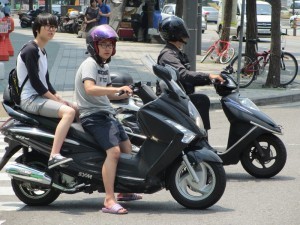
In Seoul is never too early to start riding a big bike
Describe an interesting conversation you had with a local:
My friend Yoon, who I met for the first time while living in Colombia, explained me about the strong character of korean people, that always had done face threats from their powerful neighbors Japanese and Chinese and in the last century even the diaspora of the North of the country, make South Korea an island de facto. She also told me how she had to give up on her relation with a latino guy, in a country where interracial marriage, especially for a woman, is still heavily ostracized.
What do you like about where you are? Dislike?
Liked: Seoul airport is awarded as the best in the world and one of the reason is you can spend the night instead in uncomfortable benches on the mattress of a jimjibang for a cheap fee. It was not my only visit to this beautiful concept of Korean bath house. I went to the biggest in the city, 7 floors of pure wellness. I may go to a jimjibang every day.
Dislike: in a big city there is no better place to me for people watching than the subway, but I never felt like in Seoul metro the lack of humanity and a sense of extraniation. Everyone lost in his smart phone, everyone feeling the other like a instead of a mirror where observe himself from a different angle and the world.
Describe a challenge you faced:
Not to react when pushed by people. Like in China, Koreans tend to be rude and impolite when they are in crowds. Nobody will hint at a smile if waiting the elevator with you, no matter if it’s your neighbour since you were born, instead they will cut your way as soon as the door will open. I understand it’s just the reflection of a different culture, but I will never get use to such behaviours. More than once I was pushed out badly and I had to control myself and not to throw them at least some loud insult, when their reaction at the clash was far from a “Excuse me” or “I am sorry”, instead a truce look or the pretension you don’t exist.
You are not allowed to take the subway if you don't own a smartphone
”What new lesson did you learn?
I was not even born when Pak Doo Ik turned Korea for italians into as synonym of what Waterloo is for the French, but I remember very well the scandals in Seoul Olympics in 1988: I was 17 and that was my loss of innocence. And to close the circle, the briberies in Soccer World Cup in 2002 were the cause that put the end to the great love of my 30 years long adolescence. This is how I developed a genuine hatred for everything korean in sport. But after I saw how many passionate hikers and fitness people there are in Seoul I made peace with them. Nowhere else in Asia I could see healthy bodies like here. This is one of the countries where people care and practice more sport and I must recognize their results in élite events are not just a product of corruption, but also the natural consequence of sincere passion and hard work.
Where next?
From the most homogeneous country in the world to the most diverse city per square mile I have ever been: Georgetown, Penang.
Original article can be found here: Vagabonding field reports: the soul of Seoul
Rolf Potts's Blog
- Rolf Potts's profile
- 323 followers


